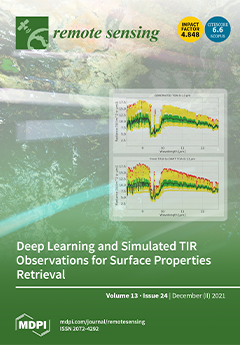The ionospheric equivalent slab thickness (τ) is defined as the ratio of the total electron content (TEC) to the F2-layer peak electron density (
NmF2), and it is a significant parameter representative of the ionosphere. In this paper, a comprehensive statistical analysis
[...] Read more.
The ionospheric equivalent slab thickness (τ) is defined as the ratio of the total electron content (TEC) to the F2-layer peak electron density (
NmF2), and it is a significant parameter representative of the ionosphere. In this paper, a comprehensive statistical analysis of the diurnal, seasonal, solar, and magnetic activity variations in the τ at Guam (144.86°E, 13.62°N, 5.54°N dip lat), which is located near the magnetic equator, is presented using the GPS-TEC and ionosonde
NmF2 data during the years 2012–2017. It is found that, for geomagnetically quiet days, the τ reaches its maximum value in the noontime, and the peak value in winter and at the equinox are larger than that in summer. Moreover, there is a post-sunset peak observed in the winter and equinox, and the τ during the post-midnight period is smallest in equinox. The mainly diurnal and seasonal variation of τ can be explained within the framework of relative variation of TEC and
NmF2 during different seasonal local time. The dependence of τ on the solar activity shows positive correlation during the daytime, and the opposite situation applies for the nighttime. Specifically, the disturbance index (DI), which can visually assess the relationship between instantaneous τ values and the median, is introduced in the paper to quantitatively describe the overall pattern of the geomagnetic storm effect on the τ variation. The results show that the geomagnetic storm seems to have positive effect on the τ during most of the storm-time period at Guam. An example, on the 1 June 2013, is also presented to analyze the physical mechanism. During the positive storms, the penetration electric field, along with storm time equator-ward neutral wind, tends to increase upward drift and uplift F region, causing the large increase in TEC, accompanied by a relatively small increase in
NmF2. On the other hand, an enhanced equatorward wind tends to push more plasma, at low latitudes, into the topside ionosphere in the equatorial region, resulting in the TEC not undergoing severe depletion, as with
NmF2, during the negative storms. The results would complement the analysis of τ behavior during quiet and disturbed conditions at equatorial latitudes in East Asia.
Full article





